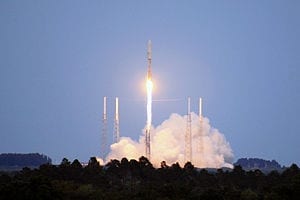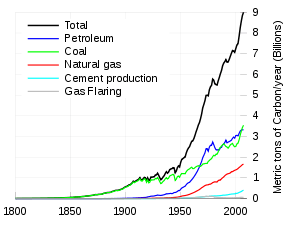
A new method of harvesting the Sun’s energy is emerging, thanks to scientists at UC Santa Barbara‘s Departments of Chemistry, Chemical Engineering, and Materials.
Though still in its infancy, the research promises to convert sunlight into energy using a process based on metals that are more robust than many of the semiconductors used in conventional methods. The researchers’ findings are published in the latest issue of the journal Nature Nanotechnology.
“It is the first radically new and potentially workable alternative to semiconductor-based solar conversion devices to be developed in the past 70 years or so,” said Martin Moskovits, professor of chemistry at UCSB.
In conventional photoprocesses, a technology developed and used over the last century, sunlight hits the surface of semiconductor material, one side of which is electron-rich, while the other side is not. The photon, or light particle, excites the electrons, causing them to leave their postions, and create positively-charged “holes.” The result is a current of charged particles that can be captured and delivered for various uses, including powering lightbulbs, charging batteries, or facilitating chemical reactions.
“For example, the electrons might cause hydrogen ions in water to be converted into hydrogen, a fuel, while the holes produce oxygen,” said Moskovits.
In the technology developed by Moskovits and his team, it is not semiconductor materials that provide the electrons and venue for the conversion of solar energy, but nanostructured metals –– a “forest” of gold nanorods, to be specific.
For this experiment, gold nanorods were capped with a layer of crystalline titanium dioxide decorated with platinum nanoparticles, and set in water. A cobalt-based oxidation catalyst was deposited on the lower portion of the array.
“When nanostructures, such as nanorods, of certain metals are exposed to visible light, the conduction electrons of the metal can be caused to oscillate collectively, absorbing a great deal of the light,” said Moskovits. “This excitation is called a surface plasmon.”
As the “hot” electrons in these plasmonic waves are excited by light particles, some travel up the nanorod, through a filter layer of crystalline titanium dioxide, and are captured by platinum particles. This causes the reaction that splits hydrogen ions from the bond that forms water. Meanwhile, the holes left behind by the excited electrons head toward the cobalt-based catalyst on the lower part of the rod to form oxygen.
According to the study, hydrogen production was clearly observable after about two hours. Additionally, the nanorods were not subject to the photocorrosion that often causes traditional semiconductor material to fail in minutes.
“The device operated with no hint of failure for many weeks,” Moskovits said.
The Latest Bing News on:
Converting sunlight into energy
- Molecule as supplier and energy storage solution for solar energyon April 20, 2024 at 12:21 am
FAU chemists conduct research into novel approach of using an organic module for storing solar energy. Until now, the generation and storage of ...
- Solar-cell-packin' drone uses sunlight for on-the-spot rechargingon April 19, 2024 at 12:19 pm
Multirotor drones may one day be able recharge their batteries while out and about, instead of having to return to a charging station. They could do so via onboard ultra-thin solar cells, which have ...
- A hydrocarbon molecule as supplier and energy storage solution for solar energyon April 19, 2024 at 6:08 am
Until now, the generation and storage of electricity from solar energy has been dependent on various devices, leading to conversion losses. That may change soon, as chemists at ...
- Chemistry researchers modify solar technology to produce a less harmful greenhouse gason April 1, 2024 at 5:00 pm
Researchers are using semiconductors to harvest and convert the sun's energy into high-energy compounds that have the potential to produce environmentally-friendly fuels. Researchers in the UNC ...
- A high-efficiency photocatalyst for converting carbon dioxide into environmentally friendly energy using sunlighton March 28, 2024 at 5:00 pm
In this regard, research on photocatalysts, capable of reducing carbon dioxide emissions while simultaneously converting it into ... on sunlight without the need for additional energy input ...
- How Do Solar Panels Work?on March 27, 2024 at 7:33 am
Learn how these systems convert sunlight into energy, what types are available, and much more in this comprehensive guide. Table of Contents Solar panel systems convert sunlight into other forms ...
- How do solar panels work? Your renewable energy system explainedon February 24, 2024 at 5:06 pm
Dan Simms is a contributing writer at USA TODAY Homefront specializing in home repair, renovation and renewable energy. While working as a property manager for one of the largest real estate ...
- BECCS: Converting Wood To Energy In The 21st Centuryon July 8, 2023 at 5:28 am
That was an age during which the clear-cutting of forests for energy purposes was ungoverned ... and forest residuals that is then converted into wood pellets. Those pellets become fuel for ...
- How Solar Panels Turn Sunlight Into Poweron May 6, 2023 at 5:31 am
They capture the energy of the sun and turn it into usable electricity. Here's a list of all the parts of a solar panel. Solar cells: These, made of silicon, convert sunlight into electrical energy.
- Plugging Into the Sunon May 15, 2018 at 1:58 pm
From this perspective, energy from the sun is virtually ... The second way is to convert sunlight directly into electricity with photovoltaic (PV) panels made of semiconductors such as silicon.
The Latest Google Headlines on:
Converting sunlight into energy
[google_news title=”” keyword=”bionic vision” num_posts=”10″ blurb_length=”0″ show_thumb=”left”] [/vc_column_text]The Latest Bing News on:
Harvesting energy from the sun
- Helpful Tips For Growing Basil To Ensure A Bountiful Harveston April 27, 2024 at 10:15 am
Basil is a popular herb known for its vibrant flavor and versatility in the kitchen. Follow these tips to cultivate robust and flavorful plants.
- Scientists achieve 'world-first' technological breakthrough in quest to extract solar power from space: 'Harnessing the power of space to benefit life on Earth'on April 27, 2024 at 3:15 am
This breakthrough shows that it may be possible to harvest solar energy directly from space cost-effectively. Scientists achieve 'world-first' technological breakthrough in quest to extract solar ...
- Murphy puts more money where the sun is. Here are N.J.’s latest solar investments.on April 26, 2024 at 9:30 am
On Friday, standing near a series of solar arrays in Berkeley Township, Gov. Phil Murphy announced more money going toward solar power programs and projects in the state. New Jersey is on course to ...
- What’s that?…A fuel cell that harvests energy from…dirt?on April 26, 2024 at 7:10 am
A soil microbial fuel cell where microbes in dirt could power applications which are literally “in the field”.
- Researchers develop sand-based technology to solve major issue with clean energy: 'This represents a new generation of storage'on April 25, 2024 at 3:30 am
"If we want to achieve our carbon reduction goals, we will need long-duration energy storage devices." Researchers develop sand-based technology to solve major issue with clean energy: 'This ...
- A simple 'twist' improves the engine of clean fuel generationon April 24, 2024 at 9:15 am
Researchers have found a way to super-charge the 'engine' of sustainable fuel generation -- by giving the materials a little twist. The researchers are developing low-cost light-harvesting ...
- When and How to Harvest Spinach at Its Peakon April 19, 2024 at 10:49 am
Mature spinach leaves usually have a more intense flavor than baby leaves and they’re harvested about 45 to 50 days after planting. Mature leaves can be harvested in either small quantities for ...
- Clean energy developer makes progress with massive energy storage project: 'It solves many issues with the grid'on April 18, 2024 at 3:00 am
The system, when complete, is more efficient and can store more energy at once than existing battery storage systems. Clean energy developer makes progress with massive energy storage project: 'It ...
- Scientists make breakthrough with advanced technology generating water from thin air — and it could save millions of liveson April 16, 2024 at 3:00 am
Researchers in China have reportedly developed a new technology similar to hydropanels for harvesting water out of thin air that is powered by energy from the sun. The device could be especially ...
- How solar panels will help Phoenix community garden harvest the sun twiceon April 12, 2024 at 8:36 pm
A local garden is taking steps to become even greener this week. Solar panels are being installed to help harness the sun twice!
The Latest Google Headlines on:
Harvesting energy from the sun
[google_news title=”” keyword=”harvesting energy from the sun” num_posts=”10″ blurb_length=”0″ show_thumb=”left”]










